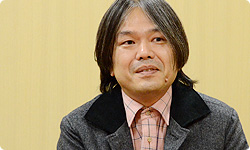I bet it took quite a while to convince the entire team that using stickers throughout was a good idea. What kind of problems arose and how were you able to solve them?
In that respect, what first got everyone frustrated was that when you use the stickers in battle, they disappear. That was pretty worrisome for people who thought, “What happens if I run out later?” or “I want to save the stickers I’ve got.”
In terms of a regular RPG, it’s like having the ’Fight’ command you’re supposed to be able to use infinitely run out when you need it.
To get people to use their stickers all the time, we made it so that you can peel off stickers from all over the courses and buy them with money at any time. We were careful to make the game flow as if to say, “Use them to your heart’s content!”
You made it so that even if you use them as soon as you get them, you’ll never run out of stickers?
Right. And we worked on the feel of the gameplay by clearly differentiating between the uses of each sticker. If you use effective stickers without hesitating against the right enemies, it feels great. That’s when I sensed it would work. Looking for stickers became really fun.
Yes, I really like that feeling when you peel off a sticker – you pull and then it pops off. I feel like someone put some work into that.
Miyamoto-san bashed that once, too! (laughs) It’s something you do all the time in the game, so he wanted it to be a little more satisfying and faster. Then we adjusted it right down to individual frames.3030. Frame: This refers to the single still images that make up a video. Traditionally in film, one second of imagery is 24 frames long – in videogames, that can vary from 30 to 60 frames depending on the game.
In addition to Mario’s series of actions, the way it feels differs by the size of the sticker. That’s really the reward of making fine adjustments.
How did it seem to you, Tanabe-san?
As far as my own impression goes, I felt like it began to change when Kudo-san understood that the ‘thing sticker’ you make by throwing ‘things’ serve in place of magic, and all sorts of interesting ideas began to come up.

How many ‘thing stickers ’ are there?
Including ‘things’ you use in the field, there ended up being over 50 types.
Another important thing was putting in the Battle Spinner and introducing some variety into battle.
What role does the Battle Spinner play?
The number of icons that match on it allow you to use that many stickers at once so you can gain an advantage in battle. You can pay even more coins to slow down the spinner and make it easier to get matching icons. Again, we paid attention here to that manual feeling that goes back to the game’s action game origin, of being able to press the buttons when you see them line up.
Clarifying the structure of battles using stickers improved the tempo of the whole game.
Yes. When we established the fighting style of storing up money through regular battles with small baddies and then pouring money into the Battle Spinner for the boss battle, I think that’s when everyone realised it would work.
But that was way towards the end!
(laughs)
For me, the Sticker Museum was incredibly important.
Sticker Museum?
It’s a place that exhibits the stickers you’ve collected. Thanks to that, my motivation shot up. When I find a sticker I’ve never seen before, I juggle around the stickers in my album and think of some way to make them fit.
Like Igata-san, when a lot of people find a sticker for the first time, they stick it in their album for the time being and then go to store it in the museum.
Basically, we want people to keep the number of stickers in their album to the minimum necessary. Then when you go to the museum with something to put up, spaces open up in your album. Then you can put new stickers there. That repetitive cycle feels great.
It was hard coming up with that cycle! (laughs)
How so?
The ‘ thing stickers’ vary in size, so you can only put a few in your album at a time. Only one exists in the game at any given time though, so if you store one in the museum, you can’t use it. That means you can’t see the effect unless you collect it again.
Yes, that happens.
Of course, we want people to use the stickers they get, but we worried that doubling the work for people who want to store them in the museum would be stressful.
For me, that’s an enjoyable dilemma.
In the end, it was structured so that the player will be torn between the two in a good way.
Yes. But we debated it until everyone said it was fine. There was a camp that agreed with the museum and there was one that was against it.
Those for it derived great pleasure from storing their stickers. (laughs)
The two really did clash. The people who first go to store something in the museum basically remember where certain stickers are and will go to get them again, so we made it with that in mind. For people who want to push ahead, we basically placed stickers so you can make use of their effect right after getting them. I think it’s balanced so that it will work well for both types of players.

In other words, it’s a game that different people can play in different ways.
Even in a more basic sense, the manner of using the album and the stickers will often be quite different depending on the person.
That way, when you look at someone’s album, you may be able to pick up on their personality to some extent, right?
Yes! (laughs) You can tell from the albums that a person doesn’t like putting much effort into things when all they use are fire stickers, or if someone just wants to collect shiny things.
I’m the type who likes to manually rearrange categories. Shoes go on a shoe page and so on.
This is great for someone obsessed with organisation. (laughs)
Right, I was diligently putting all the flowers together in one area.
I bet you could also do a personality test by looking at their album!
(laughs)
© 2024 Nintendo.